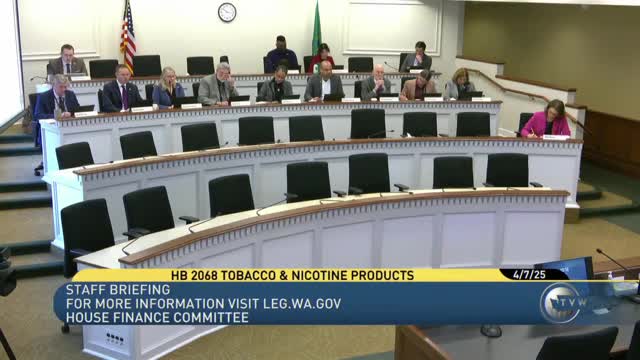House Bill 2068 targets flavored tobacco and vaping products in Washington state
April 07, 2025 | Finance, House of Representatives, Legislative Sessions, Washington
This article was created by AI summarizing key points discussed. AI makes mistakes, so for full details and context, please refer to the video of the full meeting. Please report any errors so we can fix them. Report an error »

House Bill 2068 is set to reshape Washington's tobacco and nicotine landscape by prohibiting the sale, display, and advertising of flavored tobacco and nicotine products, including entertainment vapor products, starting July 1, 2027. This significant legislation aims to combat the rising trend of youth vaping and nicotine addiction, a concern echoed by many lawmakers during the recent House Finance meeting.
The bill defines prohibited products as those that impart flavors or sensations beyond traditional tobacco, including fruit, candy, mint, and menthol. It also targets entertainment vapor products that feature interactive gaming or multimedia capabilities. To enforce these changes, retailers will be required to display signage about the new prohibitions and the Department of Health will launch a statewide prevention campaign, reporting back to the legislature by January 2027.
In addition to product restrictions, the bill proposes substantial increases in licensing fees and penalties for retailers. Annual license fees will rise to $1,000, with penalties for violations escalating significantly. For instance, a first violation for selling flavored products could incur a $2,000 fine, while repeat offenses could lead to penalties as high as $20,000 and lengthy license suspensions.
The legislation also introduces new taxes on tobacco and vapor products, including a $2 per pack tax on cigarettes, which will be adjusted for inflation every three years. This tax revenue is earmarked for youth prevention programs, reflecting a dual approach of regulation and funding aimed at reducing youth access to harmful products.
Representative Christine Reeves, the bill's prime sponsor, emphasized the personal motivation behind the legislation, sharing her own family's struggles with tobacco addiction. She highlighted the urgent need to protect the next generation from the dangers of nicotine, particularly in light of the increasing prevalence of vaping among youth.
As the bill moves forward, it represents a comprehensive effort to address public health concerns related to tobacco and nicotine use, particularly among young people. The anticipated outcomes include not only a reduction in youth vaping rates but also a more robust framework for enforcement and education surrounding tobacco products in Washington.
The bill defines prohibited products as those that impart flavors or sensations beyond traditional tobacco, including fruit, candy, mint, and menthol. It also targets entertainment vapor products that feature interactive gaming or multimedia capabilities. To enforce these changes, retailers will be required to display signage about the new prohibitions and the Department of Health will launch a statewide prevention campaign, reporting back to the legislature by January 2027.
In addition to product restrictions, the bill proposes substantial increases in licensing fees and penalties for retailers. Annual license fees will rise to $1,000, with penalties for violations escalating significantly. For instance, a first violation for selling flavored products could incur a $2,000 fine, while repeat offenses could lead to penalties as high as $20,000 and lengthy license suspensions.
The legislation also introduces new taxes on tobacco and vapor products, including a $2 per pack tax on cigarettes, which will be adjusted for inflation every three years. This tax revenue is earmarked for youth prevention programs, reflecting a dual approach of regulation and funding aimed at reducing youth access to harmful products.
Representative Christine Reeves, the bill's prime sponsor, emphasized the personal motivation behind the legislation, sharing her own family's struggles with tobacco addiction. She highlighted the urgent need to protect the next generation from the dangers of nicotine, particularly in light of the increasing prevalence of vaping among youth.
As the bill moves forward, it represents a comprehensive effort to address public health concerns related to tobacco and nicotine use, particularly among young people. The anticipated outcomes include not only a reduction in youth vaping rates but also a more robust framework for enforcement and education surrounding tobacco products in Washington.
View full meeting
This article is based on a recent meeting—watch the full video and explore the complete transcript for deeper insights into the discussion.
View full meeting
